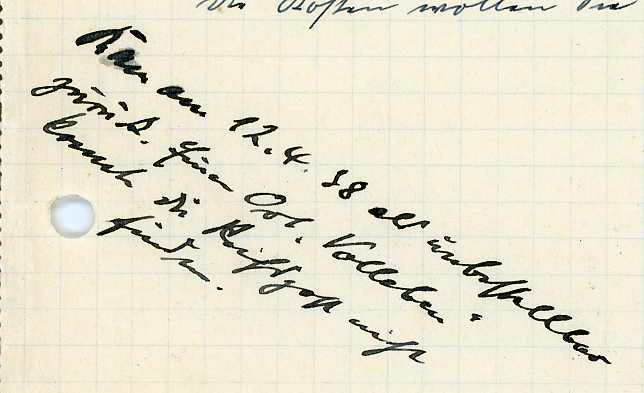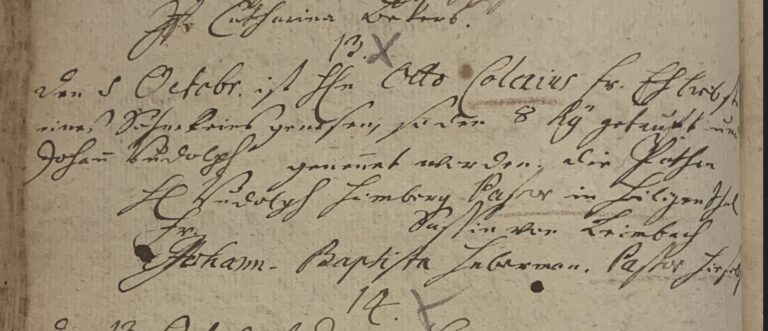Before I started.
In the 1930s, my grandfather – like every German at that time – had to document his ancestors spanning several generations.
The earliest known ancestor of my Callenius family to date – the wigmaker Johann Rudolf Callenius – married into the long-established Gleim family of Eschwege in 1760. He was said to have come from “Volleben.” Unfortunately, the town of Volleben could not be located. On a copy of a letter from my grandfather Willy Callenius dated April 7, 1938, to the parish office in Volleleben, he himself had noted in the margin: „Kam am 12.4.38 als unzustellbar zurück. Einen Ort ‘Volleben’ konnte die Reichspost nicht finden“ [Came back on 12 Apr 1938 as undeliverable. The town Volleben could not determined by the Reichspost.]. Thus, the place appears to have been unknown even in the then-German eastern territories (see picture on the right).
This was the starting point for my research into the town of Volleben, which later turned out to be POLLEBEN.

Searching for the town Volleben.
Since my research had led me to a dead end, I tried to locate the place. First, I obtained the relevant church register entry from the marriage register of the Protestant parish of Eschwege-Altstadt, dating from 1760.
The place “Volleben” is clearly recognizable here, beyond any doubt.

“Febr. d[en] 5. [1760] Johann Rudolf Colenius, von Volleben, u. Anna Gleim” [February the 5th [1760] Johann Rudolff. The record is really quite poor (no information about the parents of the bride and groom). But at least the place of origin is clearly legible.
In 1992, I wrote to the Eschwege parish office. The then retired dean there, Fritz Delius, remarked that the death dates of Rudolf and Anna Colenius cannot be found […]. The couple probably left Eschwege for professional reasons. The economic situation for wigmakers gradually declined, and the Erbprinz Regiment stationed here, which may have been one of their main customers, was relocated and deployed to America, among other places.” This was, of course, unfortunate, since the age of the before mentioned Johann Rudolf Colenius is difficult to estimate. Especially since it is unclear whether the marriage in Eschwege in 1760 was his first.
According to Delius, the place Volleben could be a town in Thuringia, in the area around Erfurt, or even in Saxony-Anhalt or around Magdeburg. The ending “-leben,” which is quite common there, supports this theory.
I wrote to the Weimar State Archives, Gotha branch. However, I received a message that the town of Volleben did not exist in that administrative district. I was advised that it might be the town of Uelleben near Gotha, since the letters “V” and “U” were often used synonymously.
At the end of 1992, I wrote to the Uelleben parish office. Pastor Kunze of the Ermleben parish office replied: “Unfortunately, I have to inform you that the name ‘Colenius’ does not appear in the church records of the Ülleben parish (I have before me the register volume of all official acts between 1638 and 1808).” I was so frustrated that I initially gave up the search.
In 2007, while searching the internet at www.ahnenforschung.org, I received two clues: One suggested it might be the town of Holleben near Halle an der Saale. Another suggested I try my luck in Wollersleben. The first clue seemed even more plausible to me than the second, but I didn’t pursue either.
Through map research in 2007, I also came up with the possibility that it could be the town of Polleben near Eisleben. However, upon inquiry, the church records there were microfilmed and therefore not available for inspection at that time.
In the spring of 2008, I came across the only useful reference concerning the town of Volleben. In a book from 1824 (“Heidelberger Jahrbücher der Literatur, Vierzehnter Jahr oder neue Folge erster Jahr, Zweite Halbe Juli bis Dezember” (Heidelberg Yearbooks of Literature, Fourteenth Year or New Series, First Year, Second Half of July to December), Heidelberg, 1824, the town of Volleben is indeed listed in the above-mentioned spelling: “im Amte Volleben, bey Eisleben.” [in the county of Volleben near Eisleben]. Thus, the town of “Volleben” really seemed to be the town of Polleben, which is just 6 km from Eisleben:
I wrote to the Polleben parish office again. After a delay of several months, the church records had been filmed and were back in the parish office. Initial feedback from the parish office revealed that “Callenius” did not appear in the church records for the relevant period. Here I was back to square one. This again didn’t seem to be the place I was looking for…

„In anderen Gegenden, z.B. im Amte Volleben, bey Eisleben, stürzt man hauptsächlich diejenigen Felder, welche zum Hausbau bestimmt sind“
The solution to the puzzle and the proof that the village Volleben is Polleben
However, I had decided to either take a trip there one day or – should I ever be in the area – pay a visit to the parish office. So it happened that I was in the area in the summer of 2020 and made an appointment with the local parish office. Unfortunately, the pastor was on vacation, but a lady from the local administration welcomed me warmly and showed me around, giving me the opportunity to review the church records and documents there. As it turned out after just five minutes, Polleben was the right place! I immediately found the name Callenius in a map, albeit spelled “Colenius.” Then I also found the baptismal record of Johann Rudolph Callenius from 1727, who married in Eschwege in 1760.


From left to right: Filing cabinet of church records; Polleben Parish Office; Street view 2021 (1); Street view 2021 (2)